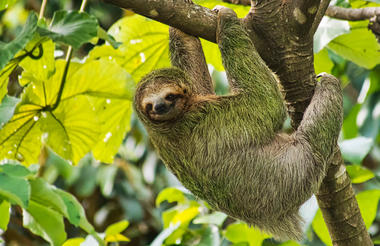Located in Central America, between Nicaragua and Panama, bathed by the Pacific and Atlantic oceans; with a population of under 5 million people and thousands of colorful species, all of whom feel proud to call this little piece of land “home".
Five percent of the world’s biodiversity can be found within Costa Rica’s borders and great efforts have been made to preserve this rich resource; protected national parks make up almost 25% of the land – more than any other country in the world. From hiking and surfing, to white water rafting and exploring volcanic regions, Costa Rica is the perfect playground for nature lovers and adventures seekers alike.
Located in central Costa Rica, the Central Valley is home to over 70% of the country’s population. This remarkably beautiful area makes up most of Costa Rica’s interior and boasts many coffee plantations blanketing the hillsides and is fringed by rugged mountains and two active volcanoes, Irazu and Poas. Visitors can look forward to a number of wonderful attractions such as: the Iglesia de San Jose Orosi, built in 1734, it is the oldest church in Costa Rica; the famous town of Cartago, the country’s oldest town; as well as Poas Volcano National Park, home to the most active volcano in the country and Irazu National Park, home to the largest and highest active volcano in Costa Rica.



The small town of San Gerardo de Dota is strung along a quiet road in the Talamanca Mountains roughly three hours from the capital, San Jose. One of the main attractions here is Los Quetzales National Park, famous among the world’s bird watching fraternity as one of the best places to view the resplendent quetzal, with its vivid green and red plumage that has earned it a reputation as one of the world's most beautiful birds. For exercise and outdoor enthusiasts, hiking is a must-do activity in the region, with fantastic paths leading through the national park and across the Rio Savregre.



Situated in southern Costa Rica, the small village of Uvita, also known as Uvita de Osa, is a little remote gem on the coast. It isn’t as overdeveloped as the other beach towns and boasts an array of wonderful attractions and activities for visitors to enjoy. Uvita serves as the gateway to the incredibly scenic Marino Ballena National Park, famous for its migrating pods of humpback whales. It features a unique peninsula, the Cola de Ballena, which translates as ’The Whale’s Tail’, which is indeed in the shape of a whale tail. Visitors can look forward to enjoying a refreshing dip in the Uvita Waterfall, as well as the enormous multi-tiered Nauyaca Waterfall and exploring the caves of Playa Las Ventanas Don’t miss the opportunity to catch a magnificent sunset over the Pacific Coast of Costa Rica, and spot colourful toucans flying around the jungle. Highlights include: the Annual Whale and Dolphin Festival, horse riding excursions, kayaking tours and excellent diving and snorkelling opportunities.



Located conveniently close to the city of San Jose, captivating Carara National Park boasts dense jungle and easy hiking trails and is considered to be one of Costa Rica’s best birding destinations. This protected area encompasses 4700 hectares and a number of distinct ecosystems, including marshlands, lagoons, and gallery forests. Lucky travellers will spot animals such two-toed Sloths, Agoutis, Armadillos, Pacas, Great Anteaters, Crocodiles, Kinkajous, Tayras, Margay cats, Collared Peccaries, White-tailed Deers, a variety of monkeys, and over 400 bird species. The park is also famous for containing one of the highest diversity of trees in the world, as well as a number of enthralling and fascinating pre-Columbian archaeological sites dating back as far as 2000 years, which can be visited along the beautiful trails.








